

The Path from a Social Brand to a Social Business. InShare706 I’ve been a long-time supporter of MediaTemple’s (MT)Residence program along with Gary Vaynerchuk, Neil Patel, and many others whom I respect.
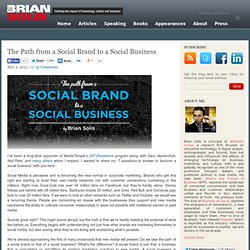
I wanted to share my “7 questions to answer to become a social business” with you here.. Social Media is pervasive and is becoming the new normal in corporate marketing. Brands who get this right are starting to build their own media networks rich with customer connections numbering in the millions. Right now, Coca-Cola has over 34 million fans on Facebook, but they’re hardly alone. Sounds great right? We’re already approaching the first of many crossroads that new media will present.
It’s a tough decision to make right now especially at a time when all we read about is how much success many businesses are finding without having to answer this very question. The report also highlighted exactly where social fits in the marketing mix today and as you can see, despite all of the hype, it’s not a dominant focus yet. The 4 Strategic Steps To A Social Business. The speed of change in society is accelerating and according to John Hagel “the average life expectancy of a company in the S&P 500 has dropped precipitously, from 75 years (in 1937) to 15 years according to a recent study”.

Social media is part of that change and has become embedded in our pscyhe at an accelerated pace in recent years and is becoming part of our DNA as human beings and you only have to look at the Facebook phenomenon to see the evidence. Social Media Is Dead Recently David Armano of Edelman and the author of the blog “Logic and Emotion” declared “Social media is dead” which in essence means that social media is no longer a separate entity that has its own existence but has evolved and become enmeshed in how we work and play online in an increasingly social web. Some companies are embracing this change while others resist and hope that things will remain the same. The Challenge. The State and Future of Enterprise Collaboration. InShare34 More than a year ago, in an article for CMS Wire, I wrote that corporations are starting to ask themselves the following questions: ”Now that we all have the tools, what shall we do with them?
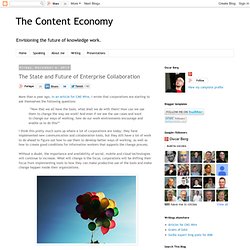
Consumer Driven IT: The Revolutionary Promise of Social Business. Here’s something you probably don’t know about social media: It’s designed to help businesses become social, and not necessarily intended to deliver traditional value or return on investment (ROI).
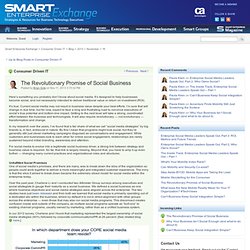
It’s true: Current social media may not result in business value despite your best efforts. I’m sure that will change in due time, but for now, expect to face a long and frustrating road to convince executives of social’s true potential and bottom-line impact. Getting to the next level will take a strong, coordinated effort between the business and technologists. It will also require revolutionary — not evolutionary — transformation and change. Quick Guide: The Collaborative Economy Body of Work for Corporations. Updated: Nov 15, 2014, with newer posts added.
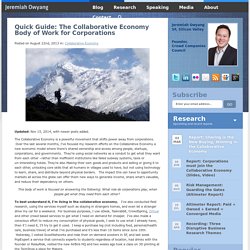
The Collaborative Economy is a powerful movement that shifts power away from corporations. Over the last several months, I’ve focused my research efforts on the Collaborative Economy a new economic model where there’s shared ownership and access among people, startups, corporations, and governments. They’re using social networks as a conduit to get what they want from each other –rather than inefficient institutions like failed subway systems, taxis or un-interesting hotels.
They’re also Making their own goods and products and selling or giving it to each other, unlocking core skills that all humans in villages used to have, but not using technology to learn, share, and distribute beyond physical borders. The impact this can have to opportunity markets all across the globe can offer them new ways to generate income, share what’s valuable, and reduce their dependency on others. Report: Corporations must join the Collaborative Economy. Right now, customers are sharing media and ideas on social technologies, in the near future, they’ll use similar technologies to share products and services, which will cause a ripple of impacts far more disruptive than what we’ve seen before.
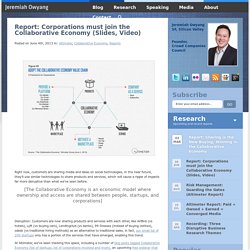
Disruption: Customers are now sharing products and services with each other, like AirBnb (vs hotels), Lyft (vs buying cars), Lendingclub (vs banks), 99 Dresses (instead of buying clothes), odesk (vs traditional hiring methods) as an alternative to traditional sales, in fact, our small list of 200 startups only has a portion of the services that have emerged, enabling this trend. At Altimeter, we’ve been tracking this space, including a number of blog posts tagged Collaborative Economy (list of startups, list of corporations involved and more), an upcoming free webinar that you can join, and I’ll be announcing some private events for our clients to dive in further. The executive summary encapsulates what you need to know:
Perfected Social Business? Good, Because Here Comes the Collaborative Economy. If you’re still trying to get a handle on social business, hang on to your bootstraps.
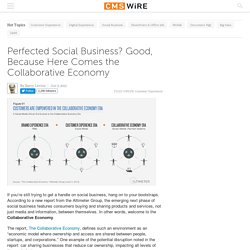
According to a new report from the Altimeter Group, the emerging next phase of social business features consumers buying and sharing products and services, not just media and information, between themselves. In other words, welcome to the Collaborative Economy. The Net’s Evolution Some adventurous companies are experimenting with new, collaborative economy models. NBC, for instance, is working with sharing site Yerdle on peer-to-peer sharing. The Collaborative Economy, according to the report, is the next step in the Internet’s evolution of e-commerce. We’re now entering a Third Phase, the Collaborative Economy Era (Social, Mobile, Payment Systems), where customers have the ability to readily share or sell goods and services, and power shifts to the consumer.
Of course, we’ve heard the “power shifts to the consumer” mantra many times before, most commonly in our current, social media era. How Big? Salesforce debuts ‘Company Communities’ to help you kill off your corporate intranet. Cloud software powerhouse Salesforce has introduced a new product called Company Communities that aims to replace boring corporate intranets with a network that emphasizes mobile and social features, the company announced today.

Company Communities is targeting businesses that already spend a lot of cash on intranet sites that employees couldn’t care less about. It aims to engage those employees by providing social interactions and tailored applications for iOS, Android, and other mobile platforms. “There are a lot of companies that want a corporate intranet but don’t have enough features,” Jim Sinai, Director of Product Marketing for Salesforce’s Platform, told VentureBeat. “Right now, legacy intranet providers aren’t user centric. SAPVoice: What Is A Social Business? 4 Resources To Help You. Venessa Miemis studies how social media influences the way people communicate and behave.
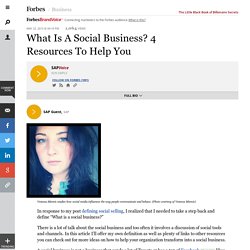
(Photo courtesy of Venessa Miemis) In response to my post defining social selling, I realized that I needed to take a step back and define “What is a social business?” Social business and the changing theory of management. A manager recently voiced his concerns: “Most employees prefer being told what to do.
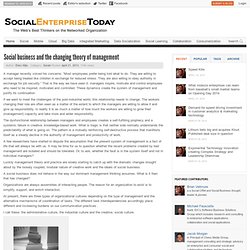
They are willing to accept being treated like children in exchange for reduced stress. They are also willing to obey authority in exchange for job security.” That is the way we have seen it: managers inspire, motivate and control employees who need to be inspired, motivated and controlled. These dynamics create the system of management and justify its continuation. If we want to meet the challenges of the post-industrial world, this relationship needs to change. A new framework for supporting learning and performance in the social workplace. Here is an updated version (V3) of the WSD Framework with more charts and descriptions, and now available as a PDF to download under a Creative Commons Licence.
Social tools are changing not only the way that professionals are working and learning but also the way that organisations are transforming into social businesses. In the new connected workplace, current training, e-learning or blended learning services, which take a top-down, ”command and control” approach to organising and managing “learning” will not be appropriate to support these new ways of working and learning. What will be required is a completely new range of services – which we might call non-training services – that are focused on supporting continuous performance improvement and learning in the workflow as people do their jobs. The Workforce Development Services (WSD) Framework comprises 4 key service areas.
Customers define what Social Means for their Business. 7 Lessons From Social Business Leaders. 3 Lessons We Can Learn From Big Brands In Social Media. This is a guest post by Kristi Bergeron from Kravetz & Company Public Relations. Social Media campaigns and contests can add a lot of excitement to brand pages. If you’ve spent anytime looking around the social web, big brands have been known to go to great lengths to create engagement amongst fans and followers. No matter the size of your business or brand, some of these ideas have some very useful takeaways we can all learn from. The three brands outlined here will give you a little creative inspiration to bump up engagement on your social media pages. How IT Can Reclaim Social Relevance - The BrainYard. Social technologies are spreading through the business in a decentralized way, not via IT leadership. How can organizations and IT leaders make the most of this trend? If there's anything that's striking about the changes taking place in technology today, it's that many of the most transformative new advances are bypassing the IT department entirely.
One only has to look at the bring-your-own-device (BYOD) phenomenon to see this clearly. A symptom of siloed #SocBiz strategies? Social-Focused IT Hires On Back Burner - The BrainYard - Cathexis: Enterprise 2.0 Innovate: Beyond Adoption to Social Process Transformation. Many companies and organizations rollout out collaboration and enterprise social networking with an initial burst of early orientation and hoopla. Once the initial excitement wears off, they are left with a “what next?” Dilemma and ask themselves how to get sustained and building engagement in order to get all the benefits of working socially.
Richard Hughes, Director of Social Strategy at Broadvision and Paul Karazuba of QuickLogic reviewed some key considerations and strategies for getting past the “shiny new toy” phase and making enterprise social networking (ESN) a productive element in enterprise workflows. As Hughes said it has to be a place where real work gets done and as it becomes an embedded experience, helps change the nature of work as well. Hughes noted that to address that problem, the processes need to come into the social network so the work takes place and gets hosted within the social network. The Six Pillars of Social Business. We humans aren’t the fastest animals on the surface of this earth. Nor are we the strongest, or the ones with the most powerful senses. Far from it.
As individuals, we are painfully weak in the eyes of nature. Sure, we are at the top of the most intelligent creatures list, but that doesn’t help much in a one-on-one situation with a bear, wolf or lion. Even most of our fellow primates would easily beat us in a one-on-one fight. Our main strength, as human beings, is our ability to coordinate our actions as a group of individuals. How To Overcome Social Business Performance Obstacles - The BrainYard. What Enterprise Social Networks Lack: Purpose - Global-cio - What makes a community tick (6 tips to make it work)
Can Salesforce replace your corporate intranet? Five Reasons Companies Are Going Social At Light Speed. By Eric Berridge Scientists at CERN recently announced they had tracked subatomic particles travelling faster than the speed of light, a discovery that -- if proven correct -- may unravel our understanding of physics. Similarly, the introduction of social media into the corporate world may undo everything we know about IT and business in general.
#GoingSocial.